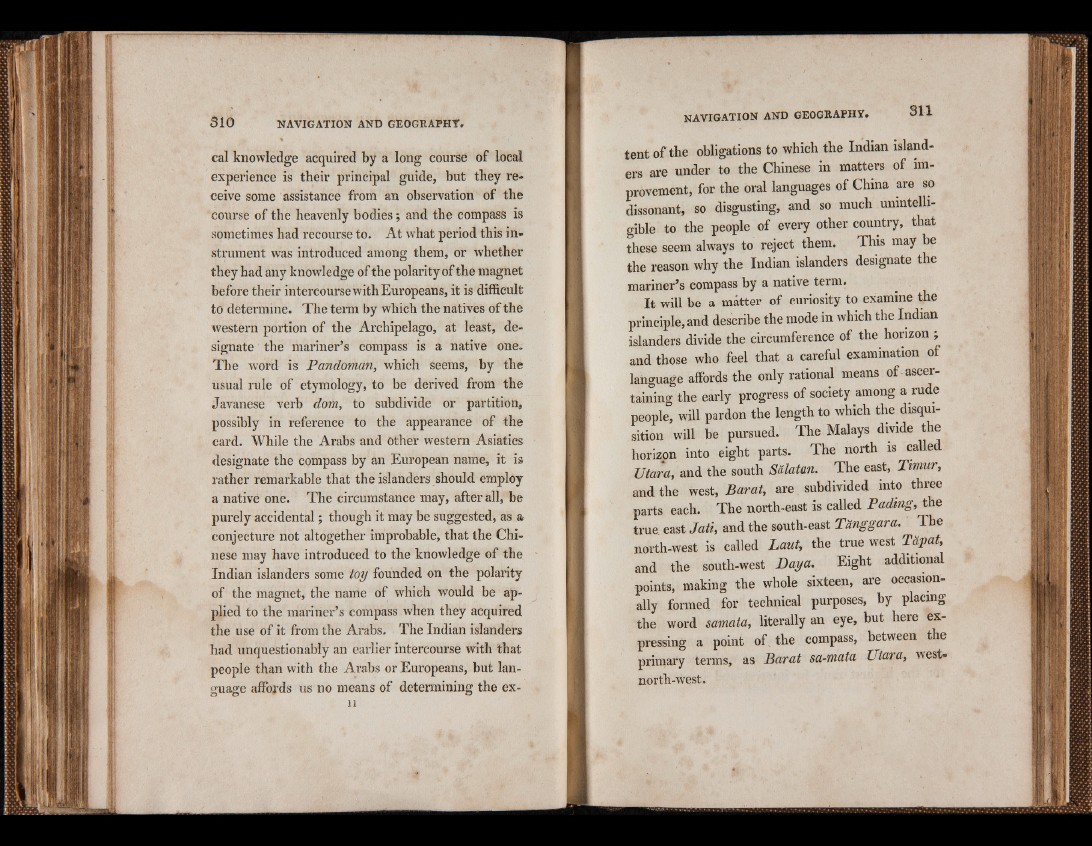
cal knowledge acquired by a long course of local
experience is their principal guide, but they receive
some assistance from an observation of the
course of the heavenly bodies; and the compass is
sometimes had recourse to. At what period this instrument
was introduced among them, or whether
they had any knowledge of the polarity of the magnet
before their intercourse with Europeans, it is difficult
to determine. The term by which the natives of the
western portion of the Archipelago, at least, designate
the mariner’s compass is a native one.
The word is Pandoman, which seems, by the
usual rule of etymology, to be derived from the
Javanese verb dom, to subdivide or partition,
possibly in reference to the appearance of the
card. While the Arabs and Other western Asiatics
designate the compass by an European name, it is
rather remarkable that the islanders should employ
a native one. The circumstance may, after all, be
purely accidental; though it may be suggested, as a
conjecture not altogether improbable, that the Chinese
may have introduced to the knowledge of the
Indian islanders some toy founded on the polarity
of the magnet, the name of which would be applied
to the mariner’s compass when they acquired
the use of it from the Arabs. The Indian islanders
had unquestionably an earlier intercourse with that
people than with the Arabs or Europeans, but language
affords us no means of determining the ex- o D o 11
tent of the obligations to which the Indian islanders
are under to the Chinese in matters of improvement,
for the oral languages of China are so
dissonant, so disgusting, and so much unintelligible
to the people of every other country, that
these seem always to reject them. This may be
the reason why the Indian islanders designate the
mariner’s compass by a native term.
It will be a matter of curiosity to examine the
principle, and describe the mode in which the Indian
islanders divide the circumference of the horizon ;
and those who feel that a careful examination of
language affords the only rational means of ascertaining
the early progress of society among a rude
people, will pardon the length to which the disquisition
will be pursued. The Malays divide the
horizon into eight parts. The north is called
Utara, and the south Salatan. The east, Timur,
and the west, Bar at, are subdivided into three
parts each. The north-east is called Pading, the
true east Jati, and the south-east Tdnggara. The
north-west is called Laut, the true west T&pat,
and the south-west Daya. Eight additional
points, making the whole sixteen, are occasionally
formed for technical purposes, by placing
the word samata, literally an eye, but here expressing
a point of the compass, between the
primary terms, as Bar at sa-mata Utara, west-
north-west.